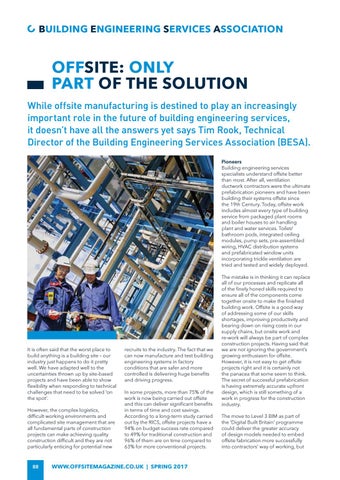BUILDING ENGINEERING SERVICES ASSOCIATION
OFFSITE: ONLY PART OF THE SOLUTION While offsite manufacturing is destined to play an increasingly important role in the future of building engineering services, it doesn’t have all the answers yet says Tim Rook, Technical Director of the Building Engineering Services Association (BESA). Pioneers Building engineering services specialists understand offsite better than most. After all, ventilation ductwork contractors were the ultimate prefabrication pioneers and have been building their systems offsite since the 19th Century. Today, offsite work includes almost every type of building service from packaged plant rooms and boiler houses to air handling plant and water services. Toilet/ bathroom pods, integrated ceiling modules, pump sets, pre-assembled wiring, HVAC distribution systems and prefabricated window units incorporating trickle ventilation are tried and tested and widely deployed.
1 It is often said that the worst place to build anything is a building site – our industry just happens to do it pretty well. We have adapted well to the uncertainties thrown up by site-based projects and have been able to show flexibility when responding to technical challenges that need to be solved ‘on the spot’. However, the complex logistics, difficult working environments and complicated site management that are all fundamental parts of construction projects can make achieving quality construction difficult and they are not particularly enticing for potential new 88
recruits to the industry. The fact that we can now manufacture and test building engineering systems in factory conditions that are safer and more controlled is delivering huge benefits and driving progress. In some projects, more than 75% of the work is now being carried out offsite and this can deliver significant benefits in terms of time and cost savings. According to a long-term study carried out by the RICS, offsite projects have a 94% on budget success rate compared to 49% for traditional construction and 96% of them are on time compared to 63% for more conventional projects.
WWW.OFFSITEMAGAZINE.CO.UK | SPRING 2017
The mistake is in thinking it can replace all of our processes and replicate all of the finely honed skills required to ensure all of the components come together onsite to make the finished building work. Offsite is a good way of addressing some of our skills shortages, improving productivity and bearing down on rising costs in our supply chains, but onsite work and re-work will always be part of complex construction projects. Having said that we are not ignoring the government’s growing enthusiasm for offsite. However, it is not easy to get offsite projects right and it is certainly not the panacea that some seem to think. The secret of successful prefabrication is having extremely accurate upfront design, which is still something of a work in progress for the construction industry. The move to Level 3 BIM as part of the ‘Digital Built Britain’ programme could deliver the greater accuracy of design models needed to embed offsite fabrication more successfully into contractors’ way of working, but
